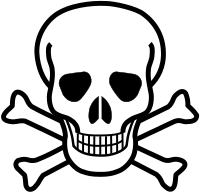Jean Hamlin
Jean Hamlin (fl. 1682-1684, last name occasionally Hamyln) was a French pirate active in the Caribbean and off the coast of Africa. He was often associated with St. Thomas' pirate-friendly Governor Adolph Esmit.
Jean Hamlin | |
|---|---|
| Nationality | French |
| Occupation | Pirate |
| Years active | 1682-1684 |
| Known for | Often associated with St. Thomas' pirate-friendly Governor Adolph Esmit |
| Piratical career | |
| Other names | Hamyln |
| Base of operations | Caribbean and off the coast of Africa |
| Commands | Trompeuse |
History
Hamlin began his career in 1682, sailing from Jamaica in a small sloop loaded with 120 men, with which he took the frigate La Trompeuse (The Trickster),[1][lower-alpha 1] which itself had changed hands between a number of pirates.[2] He quickly looted eighteen Jamaican ships, causing Jamaica's Governor Thomas Lynch to send two ships after him. The first missed him; the second, HMS Guernsey, found Hamlin but was outpaced by the freshly careened Trompeuse, which "sailed three feet to his one."[1] Lynch recruited retired pirate turned pirate-hunter John Coxon to bring in Hamlin;[2] Coxon was unsuccessful, so Lynch tried hiring buccaneer Jan "Yankey" Willems, who refused even to look for Hamlin.[3]
With so much pressure on his operations, Hamlin left his hideout at Île-à-Vache and sailed to St. Thomas where he was sheltered by Danish Governor Adolph Esmit.[2] Early in 1683 he began attacking English ships near Hispaniola (letting a French ship go free), returning to St. Thomas where Esmit helped him sell off his plunder.[4] He sailed for Sierra Leone off the African coast in May, capturing seventeen Dutch and English vessels.[2] Some of his crew split off under a Captain Morgan, taking a prize ship with them; Hamlin returned to St. Thomas. Hamlin had reportedly been very cruel to the crews of captured ships, leading Nevis' Governor William Stapleton to call him "John Hamlin, the arch murderer and torturer."[4]
The English found him there in late 1683 and HMS Francis attacked. They were fired on not only by the 32-gun Trompeuse but by the Danish fort, which infuriated the English.[5] Finally the English captured and burned Trompeuse, which exploded and set fire to another vessel left in the harbor.[5][lower-alpha 2] Hamlin escaped and Esmit protected him at Charlotte Amalie yet again. Hamlin formed a new crew late in 1684 for his ship La Nouvelle Trompeuse (The New Tricketer),[2] which had been fitted out in New England.[6] Esmit was removed from his post by exasperated Danish officials in October 1684, so Hamlin left for his old refuge at Île-à-Vache, and then to Brazil.[2] There are few records of his subsequent activities, though almost fifty of his former crew signed aboard the ships of buccaneer Jacob Evertson and privateer Jan Willems, who had previously refused to hunt down Hamlin.[6] After Willems and Evertson died in early 1688, their remaining crew (some of them formerly Hamlin's) sailed with Captain Peterson.[7]
The original Trompeuse which burned at St. Thomas was reportedly found by divers in 1990 but its authenticity is disputed.[4] Legends persist that Hamlin's loot – "treasure room was full of silver … over 24,000 pounds there" – is still aboard.[4]
In popular culture
The TV show Caribbean Pirate Treasure Season 1 Episode 7 aired on 20 August 2017. Philippe Cousteau Jr., the grandson of Jacques Cousteau, visits a group of local doctors who claim to have found the location of the Trompeuse. Cousteau even gains permission to film on the wreck site.[8]
See also
- Henry Morgan, famed buccaneer who had used Île-à-Vache as a base and hideout before Hamlin.
Notes
- Buccaneer Michiel Andrieszoon was active off South America in the same time period; his ships Le Tigre and La Mutine were occasionally confused for Hamlin's Trompeuse.
- This was the Trinity, formerly Santissima Trinidad, which had been abandoned by pirate and buccaneer Bartholomew Sharp in 1681.
References
- Marley, David (2010). Pirates of the Americas. Santa Barbara CA: ABC-CLIO. ISBN 9781598842012. Retrieved 17 August 2017.
- Lane, Kris E. (1999). Blood and Silver: A History of Piracy in the Caribbean and Central America. Oxford UK: Signal Books. pp. 128–129. ISBN 9781902669014. Retrieved 17 August 2017.
- Little, Benerson (2010). Pirate Hunting: The Fight Against Pirates, Privateers, and Sea Raiders from Antiquity to the Present. Washington DC: Potomac Books, Inc. ISBN 9781597975889. Retrieved 17 August 2017.
- "Pirate in the Caribbean (interview with historian Charles Consolvo)". National Geographic Society. National Geographic Society. 1 June 2011. Retrieved 17 August 2017.
- Ringrose, Basil (1992). A Buccaneer's Atlas: Basil Ringrose's South Sea Waggoner : a Sea Atlas and Sailing Directions of the Pacific Coast of the Americas, 1682. Berkeley CA: University of California Press. ISBN 9780520054103. Retrieved 17 August 2017.
- Little, Benerson (2007). The Buccaneer's Realm: Pirate Life on the Spanish Main, 1674-1688. Dullea VA: Potomac Books, Inc. ISBN 9781612343617. Retrieved 17 August 2017.
- Fortescue, J.W. (1899). America and West Indies: August 1688 | British History Online (Vol 12 ed.). London: Her Majesty's Stationery Office. pp. 576–593. Retrieved 25 August 2017.
- Caribbean Pirate Treasure Season 1 Episode 7
